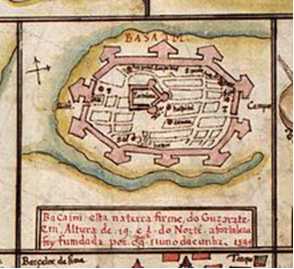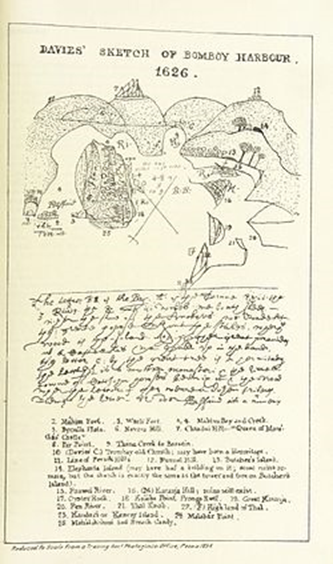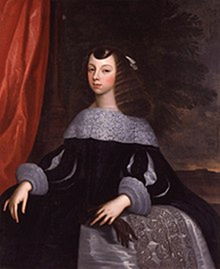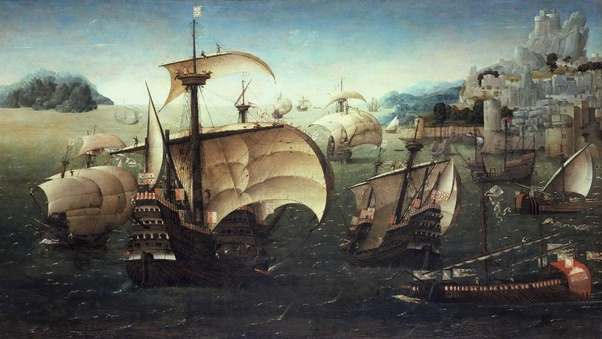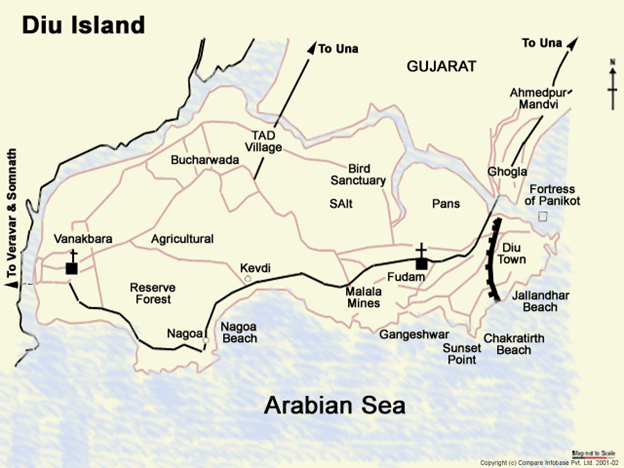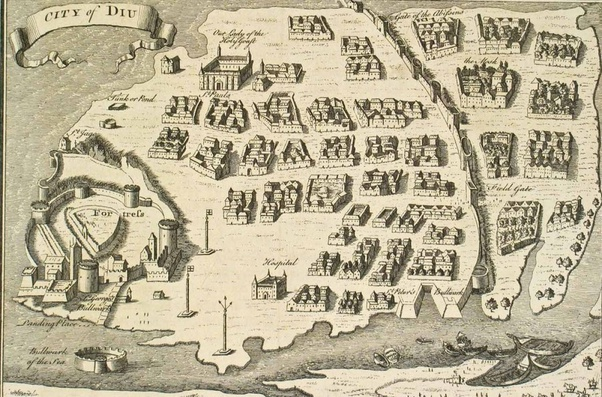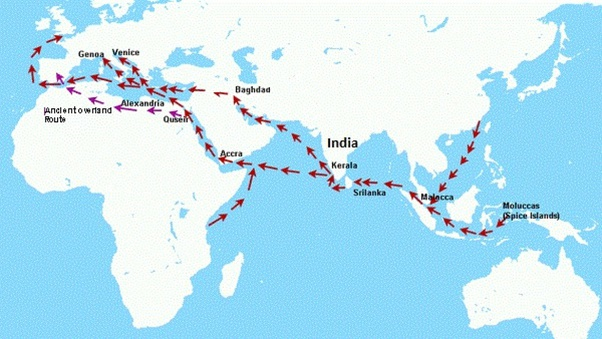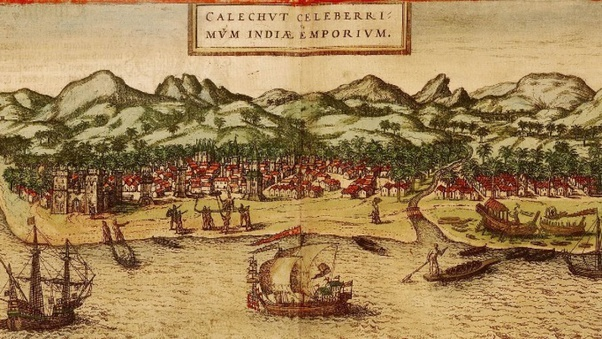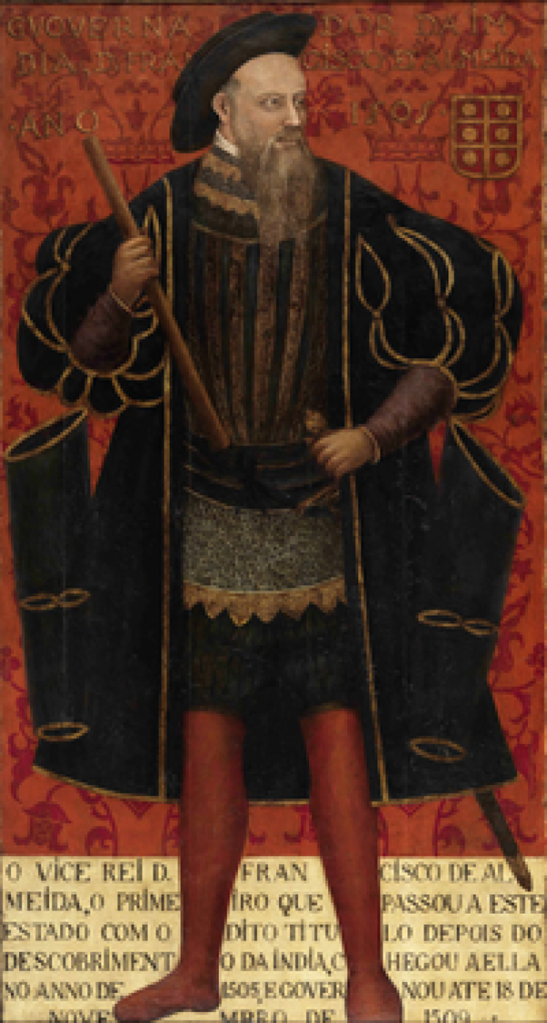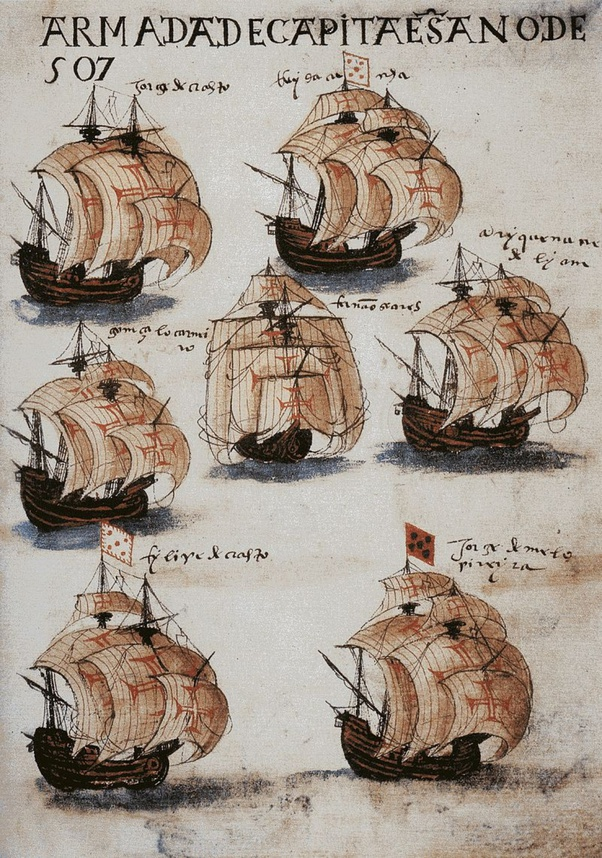The Battle of Diu – 1507: that changed the history of the world.
I was always curious about Mahim and Vasai while growing up in Bombay. I used to hear (literally only hear) about the Portuguese forts and trading, but it was never taught in our school history. Wonder why? My young mind had guessed the answer then, and later in life learned that my guess was correct though without much evidence to support full theory. That childhood guess was, that Indians then thought as they even think today that that is European history and they have nothing to do with it.
The knowledge of reality also puts a big hole in the phony argument that is made to support the name change of Bombay to Mumbai. Because at this crucial battle there was no presence of any of the Maratha fighters, or even in and around later day Bombay. English stablished their trading fort at Surat, in 1608, which was plundered three time by Maratha chieftain Shivaji, but not from anywhere close to later day Bombay. Kanho ji Angre the Maratha admiral is known to have operated from Thane creek but there is no mention of Bombay.
Bombay, Bombaim in Portuguese, became the financial and commercial capital of India. At the time of arrival of the Portuguese, current Bombay was an archipelago of seven islands. Between the third century BCE and 1348, the islands came under the control of successive Hindu dynasties. The Muslim rulers of Gujarat, who had been ruling current Thane and Vasai for a few decades, annexed the islands in 1348 that were later governed by the Gujarat Sultanate from 1391 to 1534. Growing apprehensive of the power of the Mughal emperor Humayun, Sultan Bahadur Shah of the Gujarat Sultanate was obliged to sign the Treaty of Bassein (Vasai) with the Portuguese Empire on 23 December 1534. According to the treaty, the seven islands of Bombay, the nearby strategic town of Bassein and its dependencies were offered to the Portuguese. The territories were later surrendered to Portuguese on 25 October 1535.
Map of Bombay Harbor Circa, 1626
The Portuguese were actively involved in the foundation and growth of their Roman Catholic religious orders in Bombay. They called the islands by various names, which finally took the written form Bombaim. The islands were leased to several Portuguese officers during their regime. The Portuguese Franciscans and Jesuits built several churches in the city, prominent being the St. Michael’s Church at Mahim, St. John the Baptist Church at Andheri, St. Andrew’s Church at Bandra, and Gloria Church at Byculla. The Portuguese also built several fortifications around the city like the Bombay Castle, Castella de Aguada (Castelo da Aguada or Bandra Fort), and Madh Fort. The British were in constant struggle with the Portuguese vying for hegemony over Bombay, as they recognized its strategic natural harbor and its natural isolation from land-attacks, as they endured being plundered in Surat.
By the middle of the 17th century the growing power of the Dutch Empire forced the British to acquire a station in western India. On 21 May 1662, the marriage treaty of Charles II of England and Catherine of Braganza, daughter of King John IV of Portugal, placed Bombay in possession of the British Empire, as part of dowry of Catherine to Charles. Even after the treaty, some villages in Bombay remained under Portuguese possession, but many were later acquired by the British.
How did the Battle of Diu Changed World History?
Even though this is a battle that changed the World history, not many people have heard or learned about it, and the reason for that are two, (1) the British suppression of any facts of historical importance that did not show the British importance, and (2) Successive Indian governments that followed British line, on education, also Indian people, their ignorance, and callous attitude about what was not to be “Indian” according to them.
Map shows the location of Diu, and the current status of Diu as, Centrally administered territory in India.
The Diu battle was both trade and political war. The battle was fought around island of Diu, in the Arabian Sea, that changed the course of world history. It was a big battle that heralded the end of the old world order and the beginning of the new one.
Old European depiction of the Diu Island
The Battle of Diu (1509), was the culmination of a global trade war. On one side were allied forces of the Sultanate of Gujarat, the Zamorin of Calicut, the Egyptians, and the Venetians, the ‘old’ order and on the other, the Portuguese. The decisive victory of the Portuguese in this naval battle, heralded the end of the old trading giants and led to centuries of European naval and trade dominance that shaped the modern world.
The Battle of Diu was the culmination of a global trade war
At the heart of the Battle of Diu was the global trade war for the control of the lucrative spice and textile trade. Also involved, were the egos of some powerful men and a Portuguese Viceroy’s quest for revenge, after the death of his only son.
Spice Trade route between India and Europe, through Egypt
To understand what transpired, it is very important to look at the dynamics of the spice trade between India and Europe, before the arrival of the Portuguese. From the 10th century onwards, the Marakkar merchants from Kerala and the Bania merchants from Gujarat dominated the pepper and textile trade respectively. They sold these famed products to Yemeni merchants, who in turn took these goods to Egypt and sold them to the Venetians. From there, it went to the rest of Europe.
Pepper purchased in Calicut for 4.64 ducats was sold in Portugal for 80 ducats!
Each intermediary made a lot of profit in the process. For instance, the Pepper purchased in Calicut for 4.64 ducats (European gold coins) was sold in Alexandria (Egypt), the global hub of the spice trade, for 25 ducats, five times the price. The Venetians merchants then sold it in Venice for 56 ducats and by the time it reached Lisbon (Portugal), the price of pepper was 80 ducats! No wonder, the Portuguese were so desperate to find a direct sea route to India and cut out all the middlemen. The landing of Vasco Da Gama and his fleet in Calicut in 1498, and their attempt to establish direct trade links, suddenly upset the status quo, and soon there was a reaction.
The Port of Calicut, hub of the global pepper trade
Egged on by the Marakkar Muslim merchants, the Zamorin was quick to expel the Portuguese from Calicut, and they were even quicker, in finding a new ally – the Raja of Cochin. Desperate to get their hat in, in the trade, the Portuguese soon started underselling everyone else. The Zamorin, the Sultan of Gujarat and the Venetians sent envoys to Egypt asking for help. Alarm bells were ringing in Alexandria too, as the Mamluks there had the most to lose. Ruling over dry and arid Egypt, the spice trade with India was their biggest source of revenue. Finally, in 1505, the Mamluks decided to send a massive naval armada to India to fight the Portuguese. However, they had no naval expertise and they had to take help from the Venetians.
Mamluk Fleet at Jeddah
On the 15th of September 1505, a large flotilla comprising of 1100 Mamluk soldiers, Turkish and Ethiopian mercenaries, Venetian gunners and Greek sailors, under the command of a Kurdish Admiral Amir Hussain Al-Kurdi set sail for India. After long stays at Jeddah and Hormuz, they arrived in Diu, two years later in 1507.
The Governor of Diu at that time was Malik Ayyaz, a former Russian slave, who had risen up the ranks under the Muzzafarid Sultans of Gujarat. Through his shrewd dealings, he had developed Diu into a major trading port. While he was pragmatic enough to realize the naval superiority of the Portuguese, he had no option but to follow the orders of his master, Mahmud Begada, the Sultan of Gujarat.
In March 1508, the joint naval fleets of the Mamluks and Gujarat launched an attack on the Portuguese fleet just off the coast of Chaul, in Maharashtra. While they managed to sink the Portuguese flagship, they faced heavy losses and had to retreat back to Diu. However, in this encounter, Lourenco de Almeida, the only son of Dom Francisco de Almeida, the Portuguese Viceroy of India was killed. Enraged and grief stricken Dom Francisco swore revenge. He is reported to have said ‘he who ate the chick must also eat the rooster or pay for it’.
Dom Francisco de Almedia, the Portuguese Viceroy
What started as a trade war, now turned into a saga of vendetta. Dom Francisco even defied orders from Portugal, to hand over charge and return, before he had completed his mission.
Numbers of the Forces in Battle:
- 18 Portuguese Ships vs 220 Arab Ships + Mamluk Egyptians + Venice Republic Ships
- 800 Portuguese vs 7,600 Arabs
What started as a trade war turned into a saga of vendetta.
On 9th December 1508, the Portuguese fleet set sail for Diu. They first attacked the port of Dabhol in Konkan, then under the Sultans of Bijapur. They slaughtered all the inhabitants and it is said, even the dogs. Then, they sacked the important port of Chaul and reached Mahim (part of current day Mumbai), which had been completely deserted by its inhabitants by then.
Scared by what they saw of the Portuguese aggression, at Mahim, Dom Francisco received a reconciliatory letter from Malik Ayyazz, apologizing for the death of his son. Records from the period show, that he also went out of his way, to placate the Portuguese Viceroy. This didn’t cut much ice. In response the Viceroy wrote,
‘I the Viceroy say to you, honored Meliqueaz [Malik Ayyazz] captain of Diu, that I go with my knights to this city of yours, to take the people who were welcomed there, who in Chaul fought my people and killed a man who was called my son, and I come with hope in God of Heaven to take revenge on them and on those who assist them, and if I don’t find them I will take your city, to pay for everything, and you’
Meanwhile, in Diu, the Mamluk and Gujarati fleet was reinforced by around 70 to 150 war boats sent by the Zamorin of Calicut. However, there were bitter differences between the Mamluks, the Gujaratis and the Malabaris. As the Portuguese fleet arrived in Diu on 2nd Feb 1509, Malik Ayyazz retreated inland, leaving the Mamluk admiral Amir Hussain to take command. However, the Mamluks, who had very little experience of naval battles, took a defensive position between the water channel separating Diu Island, and the mainland. This was a mistake.
The Portuguese Armada, 1507
The battle began at 11 a.m., with shots being fired from the Portuguese fleet. The superior Portuguese artillery bombarded the Mamluk fleet. The Portuguese ship Rei Grande, rammed against Amir Hussain’s flagship tipping the scales in Portuguese favor. Hussain had kept Zamorin’s light oar ships inside the channel, to attack from behind. But the Portuguese anticipated this move and blockaded the channel, as a result of which the Zamorin’s fleet could not get out and served as an easy target for Portuguese artillery. By end of the day, the entire Mamluk fleet was either destroyed or captured. Amir Hussain fled inland.
The Battle formations and positions of ships for the battle of Diu
It was a complete victory for the Portuguese. Three large ships and three medium sized ships of a Mamluk fleet were captured and sent to Lisbon. To avenge his son’s death, Dom Francisco ordered all the captured prisoners be hanged, burned alive or blown apart with cannons. He then laid a heavy fine on the merchants of Diu, who had helped the Mamluks with supplies.
The survivors from the Zamorin’s fleet managed to escape to Calicut. Amir Hussain along with 22 Mamluks fled Diu on horseback and after a long journey, returned to Cairo. It is as important as the battles of Waterloo and Trafalgar!
This battle marked a shift in power and the beginning of the dominance of Europeans, first the Portuguese, then the Dutch and then the French and the British, over the world seas.
All the referenced books agree that the battel of Diu changed the course of world history. It is more important than the battles of Waterloo and Trafalgar. Surprisingly, such an important battle has been completely forgotten in India not part of the history curriculum, and even in Europe.
Some of the changes that occurred as a result of this battel are surmised below,
- With the Battle of Diu, the Arab World fell,
- The Mediterranean World Fell,
- The Medieval World Fell,
- The old Poor became new rich,
- The closed Europe opened up,
- New World order established,
- The Old Theory-Dogmas Fell,
- The Old Little World Fell.
- And it turned over the power-center from India to Europe.
References.
- Gualdim Pais, studied Political Science at Faculdade De Direito Da Universidade De Lisboa (2010).
- 50 Battles That Changed the World’ by William Weir,
- ‘Moment of Battle: The Twenty Clashes That Changed the World’ by James Lacey,
- ‘The Fifteen Decisive Battles of the World: From Marathon to Waterloo’ by Edward Creasey
